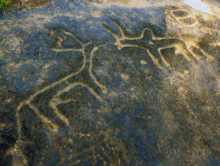"ଗୋଆ" ପୃଷ୍ଠାର ସଂସ୍କରଣଗୁଡ଼ିକ ମଧ୍ୟରେ ତଫାତ
ଟିକେ ବ/ୱ ଫଳା ବଦଳ |
Psubhashish (ଆଲୋଚନା | ଅବଦାନ) →ଇତିହାସ: ଇଂରାଜୀ ବାକ୍ୟ କଢ଼ାଗଲା |
||
| ୭୩ କ ଧାଡ଼ି: | ୭୩ କ ଧାଡ଼ି: | ||
== ଇତିହାସ == |
== ଇତିହାସ == |
||
[[File:Usgalimal.PNG|thumb|ଉସ୍ଗାଲିମାଲ୍ଠାରେ ଅବସ୍ଥିତ ପଥର ଖୋଦେଇ ଚିତ୍ର]] |
[[File:Usgalimal.PNG|thumb|ଉସ୍ଗାଲିମାଲ୍ଠାରେ ଅବସ୍ଥିତ ପଥର ଖୋଦେଇ ଚିତ୍ର]] |
||
ଗୋଆର ଇତିହାସ ୨୦,୦୦୦ରୁ ୩୦,୦୦୦ ବର୍ଷ ପୁରୁଣା । ଏହି ପଥର ଖୋଦେଇ ଭାରତରେ ପ୍ରାଚୀନ ମାନବ ସଭ୍ୟତାର ଚିହ୍ନ ବହନ କରେ ।<ref>{{cite book|last=Indian Archaeological Society|title=Purātattva, Issue 36|year=2006|publisher=Indian Archaeological Society}}</ref>{{rp|p.254}} [[Upper Paleolithic]] କିମ୍ବା [[Mesolithic]] ପଥର ଖୋଦେଇ ଚିତ୍ର, ଉସ୍ଗାଲିମାଲ୍ଠାରେ [[ |
ଗୋଆର ଇତିହାସ ୨୦,୦୦୦ରୁ ୩୦,୦୦୦ ବର୍ଷ ପୁରୁଣା । ଏହି ପଥର ଖୋଦେଇ ଭାରତରେ ପ୍ରାଚୀନ ମାନବ ସଭ୍ୟତାର ଚିହ୍ନ ବହନ କରେ ।<ref>{{cite book|last=Indian Archaeological Society|title=Purātattva, Issue 36|year=2006|publisher=Indian Archaeological Society}}</ref>{{rp|p.254}} [[Upper Paleolithic]] କିମ୍ବା [[Mesolithic]] ପଥର ଖୋଦେଇ ଚିତ୍ର, ଉସ୍ଗାଲିମାଲ୍ଠାରେ [[କୁଶାବତୀ]] ନଦୀ ତଟରେ ମିଳିଥିଲା ।<ref name=usgal>{{cite book|last=Kalyan Kumar Chakravarty, Robert G. Bednarik, Indirā Gāndhī Rāshṭrīya Mānava Saṅgrahālaya|title=Indian Rock Art and Its Global Context|year=1997|publisher=Motilal Banarsidass Publ.,|isbn= 9788120814646|pages=228 pages (see page 34)}}</ref> |
||
[[File:Kadamba.PNG|left|thumb|Gold coins issued by the Kadamba king of Goa, Shivachitta Paramadideva. ''Circa'' 1147–1187 AD.]] |
|||
Early Goan society underwent radical change when [[Indo-Aryan peoples|Indo-Aryan]] and [[Dravidian people|Dravidian]] migrants amalgamated with the aboriginal locals, forming the base of early Goan culture.<ref name=dhume2>{{cite book|last=Dhume|first=Anant Ramkrishna|title=The cultural history of Goa from 10000 BC - 1352 AD|year=1986|publisher=Ramesh Anant S. Dhume|pages=355 pages (see pages 100–150)}}</ref> |
|||
In the 3rd century BC, Goa was part of the [[Maurya Empire]], ruled by the Buddhist emperor, [[Ashoka]] of [[Magadha]]. Buddhist monks laid the foundation of Buddhism in Goa. Between the 2nd century BC and the 6th century AD, Goa was ruled by the [[Bhojas of Goa]]. [[Chutu]]s of [[Karwar]] also ruled some parts as feudatories of the [[Satavahana]]s of [[Kolhapur]] (2nd century BC to the 2nd century AD), [[Western Kshatrapas]] (around 150 AD), the [[Abhira]]s of Western Maharashtra, Bhojas of the [[Yadav caste|Yadav]] clans of [[Gujarat]], and the Konkan Mauryas as feudatories of the [[Kalachuri]]s.<ref>{{harvnb|De Souza|1990|p=[https://books.google.com/books?id=dwYDPnEjTb4C&pg=PA9&dq=bhojas+goa&lr=#v=onepage&q=bhojas%20goa&f=false 9]}}</ref> The rule later passed to the Chalukyas of [[Badami]], who controlled it between 578 and 753, and later the [[Rashtrakuta]]s of [[Malkhed]] from 753 to 963. From 765 to 1015, the Southern [[Silhara]]s of [[Konkan]] ruled Goa as the feudatories of the Chalukyas and the Rashtrakutas.<ref>{{harvnb|De Souza|1990|p=[https://books.google.com/books?id=dwYDPnEjTb4C&pg=PA10&dq=bhojas+goa&lr=#v=onepage&q=bhojas%20goa&f=false 10]}}</ref> Over the next few centuries, Goa was successively ruled by the [[Kadamba Dynasty|Kadamba]]s as the feudatories of the [[Western Chalukya Empire|Chalukyas of Kalyani]]. They patronised Jainism in Goa.<ref>{{harvnb|De Souza|1990|p=[https://books.google.com/books?id=dwYDPnEjTb4C&pg=PA11&dq=bhojas+goa&lr=#v=onepage&q=bhojas%20goa&f=false 11]}}</ref> |
|||
In 1312, Goa came under the governance of the [[Delhi Sultanate]]. The kingdom's grip on the region was weak, and by 1370 it was forced to surrender it to [[Harihara I]] of the [[Vijayanagara empire]]. The Vijayanagara monarchs held on to the territory until 1469, when it was appropriated by the [[Bahmani Sultanate|Bahmani sultans]] of [[Gulbarga]]. After that dynasty crumbled, the area fell into the hands of the [[Adil Shahi]]s of [[Bijapur Sultanate|Bijapur]], who established as their auxiliary capital the city known under the Portuguese as [[Velha Goa]] (or Old Goa).<ref name=dobbie>{{cite book|last=Dobbie|first=Aline|title=India: The Elephant's Blessing|year=2006|publisher=Melrose Press|pages=253 pages (see page 220)}}</ref> |
|||
== ଭାଷା ଓ ସାହିତ୍ୟ == |
== ଭାଷା ଓ ସାହିତ୍ୟ == |
||
୧୭:୫୩, ୧୦ ଜୁନ ୨୦୨୦ ଅନୁସାରେ କରାଯାଇଥିବା ବଦଳ
[[Category:Lua error in package.lua at line 80: module 'Module:Pagetype/setindex' not found. with short description]]
ଗୋଆ
गोंय | |
|---|---|
 ଭାରତରେ ଗୋଆର ଅବସ୍ଥାନ | |
 ଗୋଆର ମାନଚିତ୍ର | |
| ଦେଶ | |
| ସ୍ଥାପନ | ୩୦ ମଇ ୧୯୮୭ |
| ରାଜଧାନୀ | ପାଣାଜୀ |
| ବୃହତ୍ତମ ନଗର | ଭାସ୍କୋ ଡା ଗାମା |
| ଜିଲ୍ଲା ସଂଖ୍ୟା | ୨ |
| Government | |
| • ରାଜ୍ୟପାଳ | କେ. ଶଙ୍କରନାରାୟଣନ |
| • ମୁଖ୍ୟମନ୍ତ୍ରୀ | ମନୋହର ପରୀକର |
| • ନ୍ୟାୟପାଳିକା | ଏକ ନ୍ୟାୟପାଳିକା (୪୦ ଆସନ) |
| Area | |
| • ସମୁଦାୟ | 3,702 km2 (1,429 sq mi) |
| • Rank | ୨୮ଶ |
| Population (୨୦୧୧) | |
| • Total | ୧୪୫୭୭୨୩ |
| • Rank | ୨୫ |
| • Density | 390/km2 (1,000/sq mi) |
| Time zone | UTC+୦୫:୩୦ (IST) |
| ISO 3166 code | IN-GA |
| HDI | |
| HDI କ୍ରମାଙ୍କ | ୩ୟ (୨୦୦୫) |
| ସାକ୍ଷରତା | ୮୭% |
| ସରକାରୀ ଭାଷା | କୋଙ୍କଣୀ |
| Website | www.goa.gov.in |
'ଗୋଆ' ଭାରତର ଦକ୍ଷିଣ-ପଶ୍ଚିମରେ ଅବସ୍ଥିତ ଏକ ରାଜ୍ୟ । କ୍ଷେତ୍ରଫଳ ହିସାବରେ ଏହା ଭାରତର କ୍ଷୁଦ୍ରତମ ତଥା ଜନସଂଖ୍ୟା ହିସାବରେ ଏହା ଭାରତର ଚତୁର୍ଥ କ୍ଷୁଦ୍ର ରାଜ୍ୟ । ଆରବ ସାଗର କୁଳରେ ଥିବା ଏହି ରାଜ୍ୟକୁ ଉତ୍ତରଦିଗରେ ମହାରାଷ୍ଟ୍ର, ପୂର୍ବ ଓ ଦକ୍ଷିଣ ଦିଗରେ କର୍ଣ୍ଣାଟକ ଘେରି ରହିଛି । ଗୋଆ ଭାରତର ସବୁଠାରୁ ଧନୀ ରାଜ୍ୟ । ଏହାର ମୋଟ ଘରୋଇ ଉତ୍ପାଦ (ଜି. ଡ଼ି. ପି.) ଦେଶର ଜି. ଡ଼ି. ପି.ର ଅଢେଇଗୁଣ ଅଧିକ। । ୧୧ଶ ବିତ୍ତ କମିଶନ ଗୋଆକୁ ଭିତ୍ତିଭୂମି ପାଇଁ ସବୁଠୁ ଭଲ ରାଜ୍ୟ ଭାବେ ଗଣନା କରିଛନ୍ତି । ପାନାଜି ବା ପାଞ୍ଜିମ ଗୋଆର ରାଜଧାନୀ ଆଟେ । ପ୍ରାୟ ୪୫୦ବର୍ଷ ଧରି ଗୋଆ ପର୍ତ୍ତୁଗୀଜ କଲୋନୀ ରହି ଆସିଥିଲା । ୧୯୬୧ ମସିହାରେ ଏହା ଭାରତବର୍ଷ ସାଙ୍ଗରେ ଯୋଗ କରାଗଲା । ଗୋଆ ରାଜ୍ୟ ଏହାର ବେଳାଭୂମି, ବିଶ୍ୱବିଖ୍ୟାତ ଗୀର୍ଜାଘର, ଭରପୁର ଖଣିଜ ପଦାର୍ଥ ଓ ସବୁଜ ପଶ୍ଚିମଘାଟ ପର୍ବତ ମାଳା ପାଇଁ ପ୍ରସିଦ୍ଧ ଅଟେ ।
ଭୂଗୋଳ
ଇତିହାସ

ଗୋଆର ଇତିହାସ ୨୦,୦୦୦ରୁ ୩୦,୦୦୦ ବର୍ଷ ପୁରୁଣା । ଏହି ପଥର ଖୋଦେଇ ଭାରତରେ ପ୍ରାଚୀନ ମାନବ ସଭ୍ୟତାର ଚିହ୍ନ ବହନ କରେ ।[୧]:p.254 Upper Paleolithic କିମ୍ବା Mesolithic ପଥର ଖୋଦେଇ ଚିତ୍ର, ଉସ୍ଗାଲିମାଲ୍ଠାରେ କୁଶାବତୀ ନଦୀ ତଟରେ ମିଳିଥିଲା ।[୨]
ଭାଷା ଓ ସାହିତ୍ୟ
ଆଧାର
- ↑ Indian Archaeological Society (2006). Purātattva, Issue 36. Indian Archaeological Society.
- ↑ Kalyan Kumar Chakravarty, Robert G. Bednarik, Indirā Gāndhī Rāshṭrīya Mānava Saṅgrahālaya (1997). Indian Rock Art and Its Global Context. Motilal Banarsidass Publ.,. pp. 228 pages (see page 34). ISBN 9788120814646.
{{cite book}}: CS1 maint: extra punctuation (link) CS1 maint: multiple names: authors list (link)
ଅଧିକ ତଥ୍ୟ
| Goa ବାବଦରେ ଉଇକିମିଡ଼ିଆର ସହଯୋଗୀ ପ୍ରକଳ୍ପଗୁଡ଼ିକରୁ ଅଧିକ ଜାଣନ୍ତୁ: | |
| ଉଇକିଅଭିଧାନରେ ଶବ୍ଦାର୍ଥମାନ ଖୋଜନ୍ତୁ | |
| କମନ୍ସରେ ଛବି ଓ ମିଡ଼ିଆସବୁ ଖୋଜନ୍ତୁ | |
| ଉଇକିମହାବିହାରରେ ଶିକ୍ଷଣ ଆଧାରମାନ ଖୋଜନ୍ତୁ | |
| ଉଇକିସମ୍ବାଦରେ ସମ୍ବାଦ ଲେଖାମାନ ଖୋଜନ୍ତୁ | |
| ଉଇକିକଥାରୁ ଢଗଢମାଳି ଓ କଥାମାନ | |
| ଉଇକିଉତ୍ସରୁ ମୂଳାଧାର ଲେଖାମାନ | |
| ଉଇକିପୋଥିରେ ପଢ଼ାବହିମାନ | |
| ଏହି ପ୍ରସଙ୍ଗଟି ଅସମ୍ପୂର୍ଣ୍ଣ ଅଟେ । ଆପଣ ଏହାକୁ ସଂପୂର୍ଣ୍ଣ କରି ଉଇକିପିଡ଼ିଆକୁ ସମୃଦ୍ଧ କରିପାରିବେ । |
